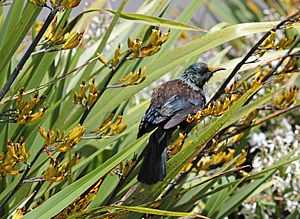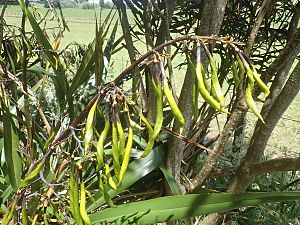Phormium colensoi facts for kids
Quick facts for kids Phormium colensoi |
|
|---|---|
 |
|
| Mountain flax being visited by a tui | |
| Scientific classification | |
| Synonyms | |
|
Phormium colensoi, also known as mountain flax or coastal flax, is a special plant found only in New Zealand. Its Māori names include wharariki, whararipi, and whatariki. This plant is a type of flax, but it's less common than its close relative, harakeke (P. tenax). Mountain flax has flowers that can be green, yellow, or orange. After the flowers, you'll see interesting twisted seed pods.
Contents
What Does Mountain Flax Look Like?
Mountain flax is easy to tell apart from its larger cousin, harakeke. Its leaves are usually shorter, growing to less than 2 metres long. Harakeke leaves, on the other hand, can be up to 3 metres long.
The flower stalk of mountain flax is also shorter. It grows up to 2 metres tall, while harakeke's stalk can reach about 5 metres. The flowers of mountain flax have green inner petals and yellow to red outer petals. Harakeke flowers are usually a dull red.
One of the easiest ways to identify mountain flax is by its seed pods. Unlike the straight pods of harakeke, the pods of P. colensoi are twisted and hang downwards. They can also be quite long, up to 20 centimetres!
Different Types of Mountain Flax
Phormium colensoi has two main forms depending on where it grows.
- The lowland form is found in the lower areas of the North Island. Its flowers usually have green or yellow petals.
- The mountain form grows in the southern and mountainous parts of the South Island, and also in some North Island ranges. This form has red petals.
Sometimes, in places like the Cook Strait area, you might find both forms growing together, and even plants that are a mix of the two!
The Name of Mountain Flax
The scientific name for mountain flax, Phormium colensoi, has a bit of a history! It was first mentioned by a person named William Colenso. Later, Joseph Dalton Hooker gave it the name P. colensoi.
For many years, another name, P. cookianum, was thought to be the correct one. This was because it was described earlier by Auguste François Le Jolis. However, after more research, P. colensoi is now often considered the accepted name by some scientists.
Even with these changes, in New Zealand, many people still prefer to use Phormium cookianum. This is because scientists are still studying the different types of flax and how they are related. It's a complex plant family!
How Māori Use Wharariki
Wharariki is a very important plant, a taonga (treasure), to Māori people. They have used different types of this flax for many purposes over hundreds of years.
Traditional Uses
- Wharariki is a special type of mountain flax from the Urewera region. Its fibres are excellent for weaving soft kete (traditional Māori baskets). When dried, the fibres turn a slightly yellow colour.
- Whakaari is another type of mountain flax. Its leaves are also good for weaving kete. However, they are not as suitable for making piupiu. Piupiu are traditional Māori waist-to-knees garments, often worn during kapa haka performances. The leaves of Whakaari are strong and dry naturally to a deep green colour. If boiled for a minute, they become a pale greenish-fawn.
Popular Cultivars
Many different types of Phormium colensoi, called cultivars, have been chosen for growing in gardens. Some of these have even won awards! The ones marked with agm have received the Royal Horticultural Society's Award of Garden Merit.
Here are a few examples:
- Black Adder
- Cream Delightagm
- Dark Delight has deep-red leaves that can grow up to 1.2 metres long.
- Duet is a small type, only about 30 centimetres tall, with cream and green striped leaves.
- Flamingo
- Golden Wonder
- Maori Maiden (also known as 'Rainbow Maiden') grows upright with bronze-striped leaves up to 1 metre long.
- Sundowner has very long leaves, up to 1.8 metres. These leaves have a purple centre and cream edges.
- Tricoloragm is an upright type with red, yellow, and green stripes on its leaves. Its flowers are pale yellowish-green.
There are also very small types of mountain flax and even hybrid cultivars. These hybrids are created by crossing P. colensoi with Phormium tenax. Generally, P. colensoi cultivars are considered a bit less tough than other flax types in very cold weather.



